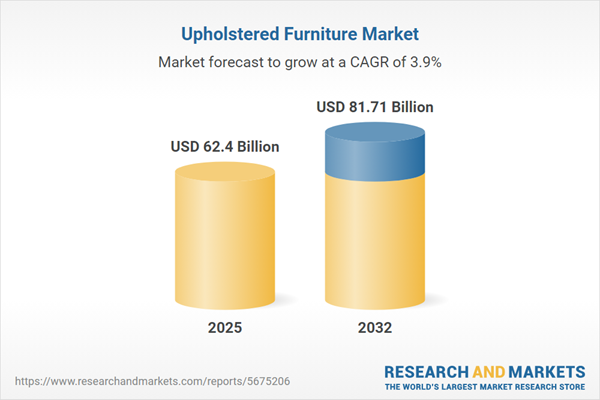Speak directly to the analyst to clarify any post sales queries you may have.
The upholstered furniture market is undergoing significant transformation, driven by rapid changes in supply chain structures, increased digitalization, and evolving buyer expectations. Senior leaders are re-evaluating strategies to stay ahead in a competitive landscape that demands data-driven agility and operational excellence across diverse commercial and residential settings.
Market Snapshot: Growth and Competitive Dynamics in the Upholstered Furniture Market
The upholstered furniture market is currently valued at USD 59.98 billion and is projected to reach USD 62.40 billion by 2025, rising further to USD 81.71 billion by 2032. A compound annual growth rate of 3.93% underpins this expansion, spurred by ongoing product innovation and active engagement with end users. The increasing adoption of advanced analytics has enabled streamlined offering development. To capture sustainable market share, market participants must respond to heightened competition, new regulations, and shifting consumer purchase behaviors with operational agility and refined cross-segment strategies.
Scope & Segmentation: Strategic Pillars for Market Leadership
Effective segmentation and regional insight are crucial for organizations looking to optimize their position within the global upholstered furniture market. The following areas are central to strategic planning and investment decisions:
- Product Types: Portfolios include chairs, loveseats, ottomans, recliners (manual and powered), modular sectionals, corner units, and sofas. Modular designs are tailored for flexible workspace and urban environments, allowing organizations to rapidly respond to changing spatial and functional requirements.
- Material Types: Key materials span cotton, polyester, velvet, PU and PVC faux leathers, microfiber, and genuine leather. Choice of materials is influenced by durability, sustainability demands, and regulatory compliance needs.
- Applications: Offerings are developed for hospitality, healthcare, commercial office, and multi-family residential markets. Customization helps organizations align products with the operational, design, and regulatory standards unique to each segment, broadening relevance and ROI.
- Sales Channels: Stakeholders utilize traditional retail, specialty distributors, large-surface merchandisers, direct-to-consumer e-commerce, online marketplaces, and digital sales platforms. These diverse channels enable optimized market reach and improved customer access.
- Regional Coverage: The sector operates across the Americas, Europe, Middle East, Africa, and Asia-Pacific. Companies must adjust offerings and supply strategies to meet varied consumer preferences and policy environments across these regions.
- Companies Analyzed: The competitive field features Ashley Furniture Industries, INGKA Holding BV, Steinhoff International Holdings, La-Z-Boy Incorporated, Natuzzi SpA, RH Inc., Ethan Allen Interiors, HNI Corporation, Kimball International, and Hooker Furnishings. Their collective approaches illustrate best practices in partnership development and operational efficiency.
Key Takeaways for Senior Decision-Makers
- Expanding modular ranges enables businesses to adapt product lines efficiently for both evolving workspaces and residential projects, boosting flexibility and competitive adaptation.
- Investments in digital technologies such as online showrooms and visualization tools improve transparency in the selection process and accelerate decision-making cycles for procurement teams.
- Emphasizing responsible material sourcing and sustainable manufacturing processes supports compliance and enhances trust among partners and clients at every value chain stage.
- Utilizing artificial intelligence to tailor offerings and anticipate preferences enables deeper client engagement and supports proactive market alignment throughout product life cycles.
- Combining physical and digital sales approaches ensures a seamless client experience, improving responsiveness to procurement shifts and maximizing both market penetration and brand relevance.
- Adopting collaboration platforms and advanced manufacturing systems speeds up product innovation while enabling consistent regulatory adherence in international markets.
Tariff Impact on Supply Chain and Operations
Ongoing US tariff policy discussions require organizations to continually assess procurement and pricing frameworks. Diversifying suppliers and integrating vertically are strategies that help mitigate supply risks, ensure operational continuity, and build resilience amid shifting trade dynamics.
Methodology & Data Sources
This analysis integrates insights from executive-level interviews, expertise from supply chain and product leaders, proprietary market assessments, and cross-verified industry datasets. The approach provides senior leadership with robust, actionable insight relevant to the upholstered furniture sector.
Why This Report Matters
- Enables leadership to benchmark strategic direction and recognize underlying drivers of growth and long-term performance within the sector.
- Delivers practical frameworks for segmentation and innovation, equipping organizations to refine product portfolios and adapt to evolving market and procurement needs.
- Provides critical intelligence for addressing market challenges such as supply chain disruption, regulatory changes, and shifts in operational expectations.
Conclusion
Focusing on transparent supply chains and digital infrastructure is vital for organizational strength. Leaders leveraging analytics and strong compliance will be best equipped to realize strategic opportunities and sustain growth amid continued industry evolution.
Additional Product Information:
- Purchase of this report includes 1 year online access with quarterly updates.
- This report can be updated on request. Please contact our Customer Experience team using the Ask a Question widget on our website.
Table of Contents
3. Executive Summary
4. Market Overview
7. Cumulative Impact of Artificial Intelligence 2025
Companies Mentioned
The companies profiled in this Upholstered Furniture market report include:- Ashley Furniture Industries, LLC
- INGKA Holding B.V.
- Steinhoff International Holdings N.V.
- La-Z-Boy Incorporated
- Natuzzi S.p.A.
- RH, Inc.
- Ethan Allen Interiors Inc.
- HNI Corporation
- Kimball International, Inc.
- Hooker Furnishings Corporation
Table Information
| Report Attribute | Details |
|---|---|
| No. of Pages | 191 |
| Published | November 2025 |
| Forecast Period | 2025 - 2032 |
| Estimated Market Value ( USD | $ 62.4 Billion |
| Forecasted Market Value ( USD | $ 81.71 Billion |
| Compound Annual Growth Rate | 3.9% |
| Regions Covered | Global |
| No. of Companies Mentioned | 11 |









